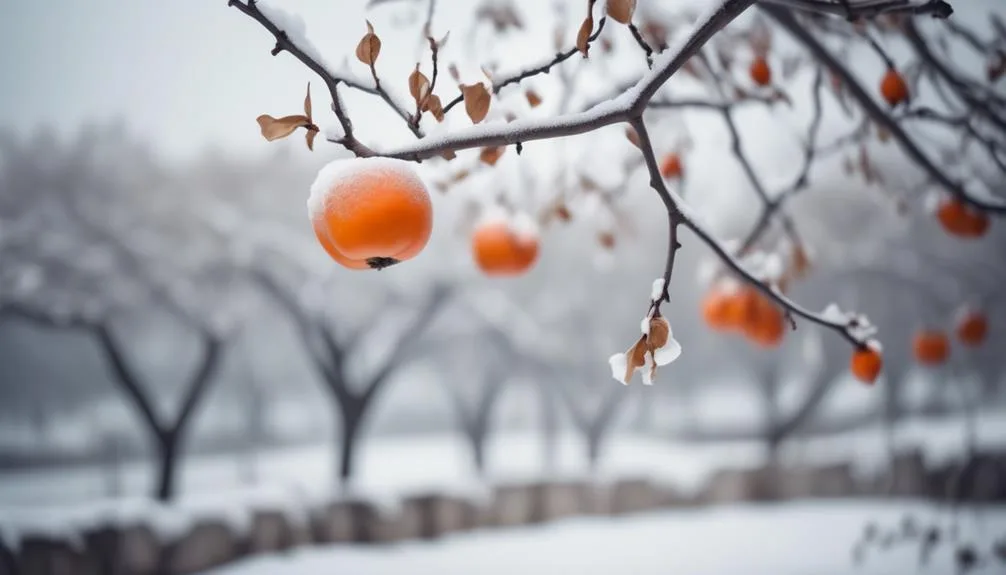If you've always wanted to grow persimmon trees but live in a cold climate, you might be in luck. It's possible to make persimmons thrive in chilly weather, and we'll show you how.
But before you start planning your orchard, there are some important things to think about.
Key Takeaways
- American persimmon is a suitable variety for cold climates, as it is hardy and reliable.
- Persimmon trees are generally hardy to USDA zones 4-9, with American persimmons being more cold-hardy than Asian persimmons.
- Winter protection measures such as mulching, wrapping the trunk, building shelters, and pruning dead branches are important for safeguarding persimmon trees during harsh weather conditions.
- Frost-resistant varieties should be chosen for successful harvesting in cold climates, and persimmons should be harvested before the first hard frost to avoid fruit damage.
Suitable Persimmon Tree Varieties for Cold Climates
When looking for persimmon tree varieties that thrive in cold climates, consider the American persimmon as a hardy and reliable option. This variety is well-suited for colder regions and offers fruit that's typically smaller in size compared to Asian persimmons.
When planting, ensure adequate spacing between trees, as American persimmons can spread up to 25 feet wide. Regarding pollination, this variety may require a separate male tree for fruit production.
Additionally, it's important to be mindful of common fruit pests such as aphids and Japanese beetles. By maintaining proper care and addressing pollination needs and potential pests, you can successfully grow American persimmon trees in cold climates, yielding delicious fruit and adding natural beauty to your landscape.
Cold Hardiness of Persimmon Trees
To ensure successful growth of persimmon trees in cold climates, it's crucial to understand their cold hardiness and how to protect them from harsh winter conditions.
Persimmon trees are generally hardy to USDA zones 4-9, but their specific cold tolerance can vary depending on the variety. American persimmons (Diospyros virginiana) are more cold-hardy than Asian persimmons (Diospyros kaki), with the ability to withstand temperatures as low as -25°F once established.
When cultivating persimmon trees in cold climates, it's important to select a site with well-draining soil to prevent waterlogging, which can lead to root rot. Additionally, a sunny location and protection from strong winds can help mitigate cold damage.
Mulching the soil around the base of the tree can also provide insulation and protect the roots during winter.
Winter Protection for Persimmon Trees
For effective winter protection of your persimmon trees in cold climates, consider implementing mulching and wrapping techniques to safeguard them from harsh weather conditions.
Here are some tips to help protect your persimmon trees during winter:
- Mulching: Apply a thick layer of mulch around the base of the tree to insulate the roots and retain moisture.
- Wrapping: Wrap the trunk of the tree with burlap or tree wrap to shield it from freezing temperatures and harsh winds.
- Shelter building: Construct a simple shelter around the tree using stakes and burlap to provide additional protection from snow and ice.
- Pruning: Trim any dead or damaged branches before winter to promote healthy growth and reduce the risk of breakage from heavy snow or ice.
Planting and Care Tips for Cold Climate Persimmon Trees
After safeguarding your persimmon trees from harsh winter conditions, it's essential to focus on proper planting and care tips to ensure their thriving in cold climates. Below are some essential planting and care tips for cold climate persimmon trees:
| Pruning Techniques | Soil Preparation |
|---|---|
| Prune persimmon trees in late winter to early spring to remove dead or diseased branches and to shape the tree for better sunlight exposure. | Ensure the soil is well-draining and slightly acidic with a pH of 6.0-6.5. Incorporate organic matter such as compost or well-rotted manure into the soil before planting to improve soil structure and fertility. |
Harvesting Persimmons in Cold Climates
When harvesting persimmons in cold climates, timing is crucial to ensure you gather ripe and flavorful fruits. Here are some tips for cold weather harvesting:
- Choose frost-resistant varieties to withstand colder temperatures and ensure a successful harvest.
- Monitor the weather closely and harvest your persimmons before the first hard frost, as this can damage the fruit.
- To determine ripeness, look for a deep color and slightly soft texture. Persimmons are ready to harvest when they easily come off the tree with a gentle twist.
- Consider using protective coverings or blankets to shield the fruits from early frosts, extending the harvesting period.
- Once harvested, store persimmons in a cool, dark place to allow them to continue ripening and develop their sweet flavor.
Harvesting persimmons in cold climates requires careful attention to weather conditions and fruit ripeness to ensure a successful harvest.
Conclusion
In cold climates, persimmon trees can thrive with the right care and suitable varieties. By choosing cold-hardy options like the American or Asian persimmon and following our planting and care tips, you can enjoy a successful harvest of delicious fruits.
Consider the possibilities of growing your own persimmon tree in a cold climate and savor the rewards of your efforts. Happy growing!

